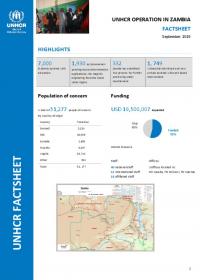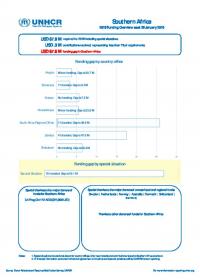Operations

OPERATIONS
Africa
- Central Africa and the Great Lakes
- Burundi
- Cameroon
- Central African Republic
- Congo
- Democratic Republic of the Congo
- Rwanda
- United Republic of Tanzania
- East and Horn of Africa
- Southern Africa
- West Africa
Americas
Asia and the Pacific
Europe
Middle East and North Africa
NEW: 2016 planning information has just been released. Budgets and population planning figures for 2016 and for previous years can be reviewed below. The French version is available in pdf format.
Location
{"longitude":28,"latitude":-13,"zoom_level":0}
Latest update of camps and office locations 13 January 2016. By clicking on the icons on the map, additional information is displayed.
Operational Highlights
Operational context and population trends
The political situation in Zambia is expected to remain stable throughout 2016 - 2017, though periodic tensions are anticipated as the country approaches the general elections in the last quarter of 2016. As a result, attention is likely to shift away from refugee related issues, including the passing of the Refugee Act. Overall protection concerns relate to Zambia’s encampment policy, which stems from Zambia’s reservations to the 1951 Refugee Convention, and has resulted in restrictions on freedom of movement and the right to work for refugees.
UNHCR’s 2016 plan is based on the following assumptions:
Key priorities in 2016
The operation will continue providing protection and basic essential services on a reduced scale while continuing to search for durable solutions. Possible solutions for Congolese refugees are limited due to the volatile security situation in the DRC which makes voluntary repatriation impossible for many.
The refugee programme will prioritize the following areas:
The political situation in Zambia is expected to remain stable throughout 2016 - 2017, though periodic tensions are anticipated as the country approaches the general elections in the last quarter of 2016. As a result, attention is likely to shift away from refugee related issues, including the passing of the Refugee Act. Overall protection concerns relate to Zambia’s encampment policy, which stems from Zambia’s reservations to the 1951 Refugee Convention, and has resulted in restrictions on freedom of movement and the right to work for refugees.
UNHCR’s 2016 plan is based on the following assumptions:
- The population of concern to UNHCR is expected to gradually decrease over the next two years, due mainly to the repatriation of up to 2,000 Angolans and the progress achieved through local integration (relocation to the settlements) of some 6,000 Angolans
- The arrival rate of asylum-seekers, particularly from the Democratic Republic of Congo (DRC), is expected to reach around 750 per year, based on past trends
- The total population of concern towards the end of 2017 is estimated to stand at 37,266 individuals: 28,875 refugees, 540 asylums-seekers and 7,851 other people of concern (former Angolan and Rwandans refugees whose status ceased in 2012 and 2013 respectively).
Key priorities in 2016
The operation will continue providing protection and basic essential services on a reduced scale while continuing to search for durable solutions. Possible solutions for Congolese refugees are limited due to the volatile security situation in the DRC which makes voluntary repatriation impossible for many.
The refugee programme will prioritize the following areas:
- Child protection – Strengthening the capacity of partners to conduct best interest determination procedures and identify solutions for unaccompanied minors
- Prevention of detention – Implementing UNHCR’s detention strategy, with special emphasis on preventing detention of children and identifying alternatives to detention
- SGBV – Organizing outreach and sensitization activities on SGBV for affected communities
- Statelessness – Supporting the Government to fulfil its pledge of signing the 1961 Statelessness Convention
- Self-reliance – Organizing activities to facilitate UNHCR’s progressive disengagement from providing direct assistance to refugees
- Education – Distributing scholarships for unaccompanied minors and other vulnerable children.
- Camp facilities – Ensuring that refugees in the settlements have access to potable water and health services.
Stories
People of Concern
5%
Decrease in
2014
2014
| 2014 | 50,216 |
| 2013 | 53,019 |
| 2012 | 50,398 |

[["Refugees",25578],["Asylum-seekers",2186],["Others of concern",22452]]
Loading ...
Budgets and Expenditure for Zambia
< Back
2014
{"categories":[2012,2013,2014,2015,2016],"budget":[17.91054247,14.99645596,13.77666413,19.66340759,17.46076085],"expenditure":[8.62723189,8.00941753,9.46195797,null,null]}
{"categories":[2012,2013,2014,2015,2016],"p1":[17.91054247,14.99645596,13.77666413,19.66340759,17.46076085],"p2":[null,null,null,null,null],"p3":[null,null,null,null,null],"p4":[null,null,null,null,null]}
{"categories":[2012,2013,2014,2015,2016],"p1":[8.62723189,8.00941753,9.46195797,null,null],"p2":[null,null,null,null,null],"p3":[null,null,null,null,null],"p4":[null,null,null,null,null]}
Loading ...




